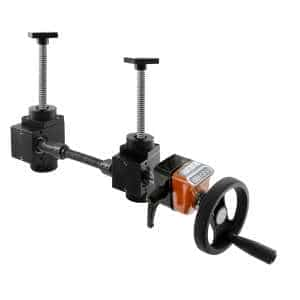
Screw jacks are a fundamental building block for many machines that require controlled linear motion. They offer a simple yet powerful way to convert rotary motion (like a motor turning) into precise linear movement (like pushing or pulling an object). This article will equip you with the essentials of understanding translating screw jacks.
The Basics:
A translating screw jack consists of three key components:
- Screw: This is a threaded shaft, typically made of high-strength steel.
- Nut: This is a threaded component that mates with the screw. It can be fixed in place, or it can be free to move along the screw, depending on the desired motion.
- Drive Mechanism: This can be a motor, hand crank, or other device that rotates the screw.
As the screw rotates, its threads push against the nut, causing the nut to move linearly along the screw’s axis. This linear movement can be used for various purposes, such as lifting heavy objects, applying precise pressure, or controlling the position of a machine element. For more information on screw jack design and material selection, you can visit MechJacks https://mechjacks.com/en/. MechJacks is a leading manufacturer of high-quality screw jacks, offering a wide range of options to suit various industrial applications.
Key Considerations:
Here are some important things to consider when working with translating screw jacks:
- Lead: This is the distance the nut travels along the axis for each complete revolution of the screw. A larger lead translates to faster linear movement but requires more rotations for the same distance.
- Capacity: Screw jacks have a rated load capacity, which is the maximum force they can handle without failure.
- Efficiency: Some energy is lost due to friction during operation. Efficiency is a factor when choosing a screw jack for a specific application.
- Accuracy: Screw jacks offer precise linear movement, but factors like lead screw quality and backlash (looseness between screw and nut) influence accuracy.
Applications:
Translating screw jacks find use in a wide range of applications, including:
- Industrial Automation: They are used in robotics, material handling, and assembly lines for precise positioning tasks.
- Construction: Screw jacks are employed for lifting heavy equipment, adjusting jacks, and leveling machinery.
- Manufacturing: They are essential for presses, jigs, and fixtures that require controlled linear force.
- Medical Equipment: Screw jacks are used in adjustable beds, wheelchairs, and other equipment requiring precise positioning.
Choosing the Right Screw Jack:
When selecting a screw jack, consider the required lead, capacity, efficiency, and accuracy for your specific application. Manufacturers offer various screw jack designs with different lead screw types (acme, ball screw etc.), materials, and lubrication options to suit diverse needs.
By understanding the basics and key considerations of translating screw jacks, you can effectively utilize them for precise linear motion in your projects.

